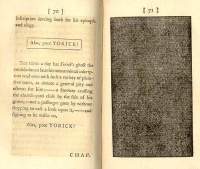Document
From The Art and Popular Culture Encyclopedia
| Revision as of 11:15, 11 April 2024 Jahsonic (Talk | contribs) ← Previous diff |
Revision as of 11:16, 11 April 2024 Jahsonic (Talk | contribs) Next diff → |
||
| Line 4: | Line 4: | ||
| [[Image:The black page in Tristram Shandy.jpg|thumb|right|200px|The [[black page]] in ''[[The Life and Opinions of Tristram Shandy, Gentleman]]'' (1759-1767)]] | [[Image:The black page in Tristram Shandy.jpg|thumb|right|200px|The [[black page]] in ''[[The Life and Opinions of Tristram Shandy, Gentleman]]'' (1759-1767)]] | ||
| {{Template}} | {{Template}} | ||
| - | A '''document''' contains [[information]]. It often refers to an actual product of [[writing]] or [[recording]] and is usually intended to communicate or store collections of [[data]]. Documents are often the focus and concern of [[business| business administration]] and [[government|government administration]]. The word is also used as a verb as "documenting" describes the process of making a document. | ||
| - | The term ''document'' may be applied to any discrete representation of meaning, but usually it refers to something physical like one or more [[printed]] [[page (paper)|page]]s, or to a "virtual" document in [[electronic]] (digital) format. | + | A '''document''' is a [[writing|written]], [[drawing|drawn]], presented, or memorialized representation of thought, often the manifestation of [[nonfiction|non-fictional]], as well as [[fiction]]al, content. The word originates from the Latin ''{{Lang|la|Documentum}}'', which denotes a "teaching" or "lesson": the verb ''{{Lang|la|doceō}}'' denotes "to teach". In the past, the word was usually used to denote written proof useful as [[evidence]] of a truth or fact. In the [[computer age|Computer Age]], "document" usually denotes a primarily textual [[computer file]], including its structure and format, e.g. fonts, colors, and [[Computer-generated imagery|images]]. Contemporarily, "document" is not defined by its [[transmission medium]], e.g., paper, given the existence of [[electronic document]]s. "Documentation" is distinct because it has more denotations than "document". Documents are also distinguished from "[[Realia (library science)|realia]]", which are three-dimensional objects that would otherwise satisfy the definition of "document" because they memorialize or represent thought; documents are considered more as two-dimensional representations. While documents can have large varieties of customization, all documents can be shared freely and have the right to do so, creativity can be represented by documents, also. History, events, examples, opinions, etc. all can be expressed in documents. |
| ==See also== | ==See also== | ||
| Related concepts: | Related concepts: | ||
Revision as of 11:16, 11 April 2024

|
Related e |
|
Featured: |
A document is a written, drawn, presented, or memorialized representation of thought, often the manifestation of non-fictional, as well as fictional, content. The word originates from the Latin Template:Lang, which denotes a "teaching" or "lesson": the verb Template:Lang denotes "to teach". In the past, the word was usually used to denote written proof useful as evidence of a truth or fact. In the Computer Age, "document" usually denotes a primarily textual computer file, including its structure and format, e.g. fonts, colors, and images. Contemporarily, "document" is not defined by its transmission medium, e.g., paper, given the existence of electronic documents. "Documentation" is distinct because it has more denotations than "document". Documents are also distinguished from "realia", which are three-dimensional objects that would otherwise satisfy the definition of "document" because they memorialize or represent thought; documents are considered more as two-dimensional representations. While documents can have large varieties of customization, all documents can be shared freely and have the right to do so, creativity can be represented by documents, also. History, events, examples, opinions, etc. all can be expressed in documents.
See also
Related concepts:
- Data storage device: to store documents.
- Media type: document parts (text block, illustration, audio sample, etc.) can use different media types to store and "display" it.
- Internet of Things
- Realia (library science)
- Subject (documents)
Other related articles:
- Historical document
- Desktop publishing
- Word processor
- Documentary
- Documentary film
- Documentation science
.jpg)


